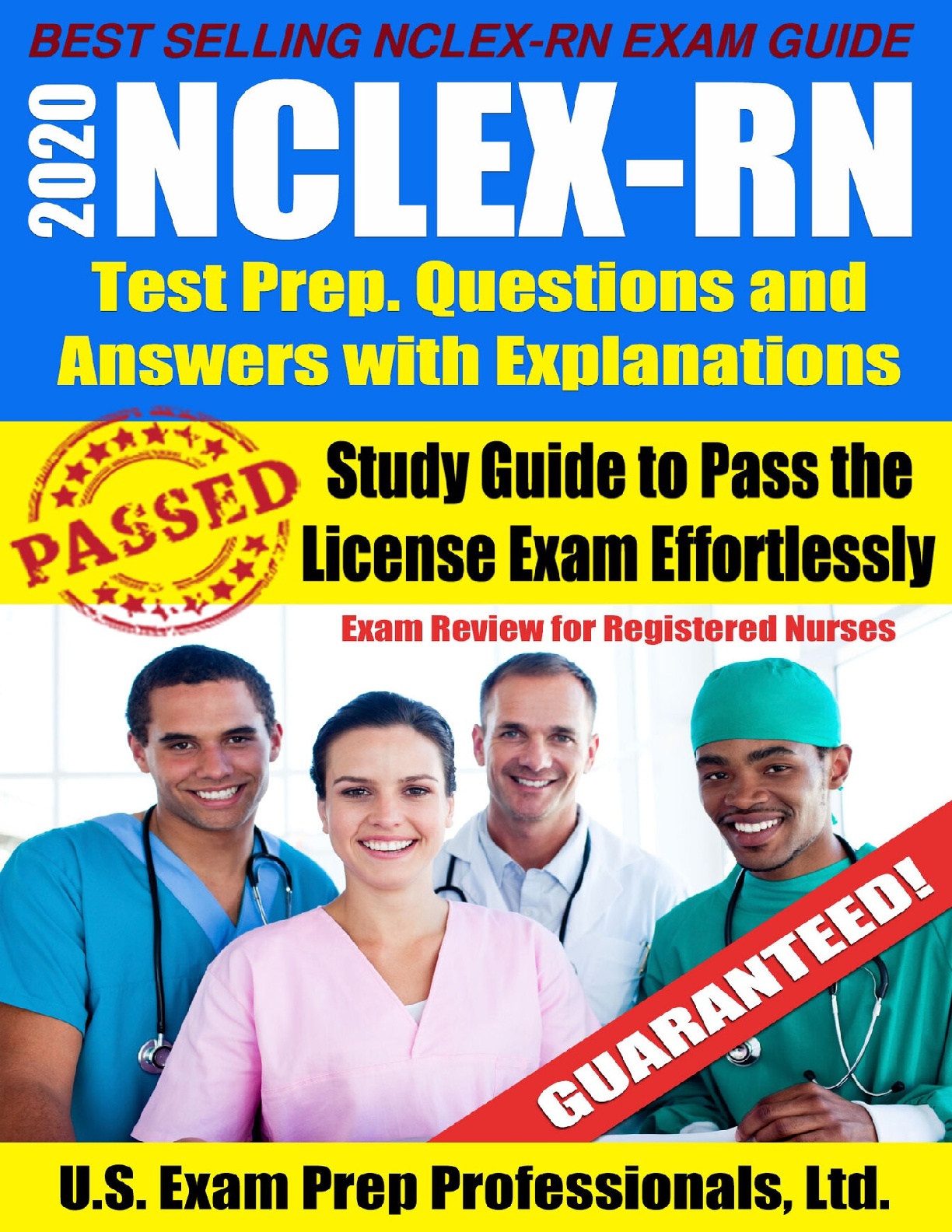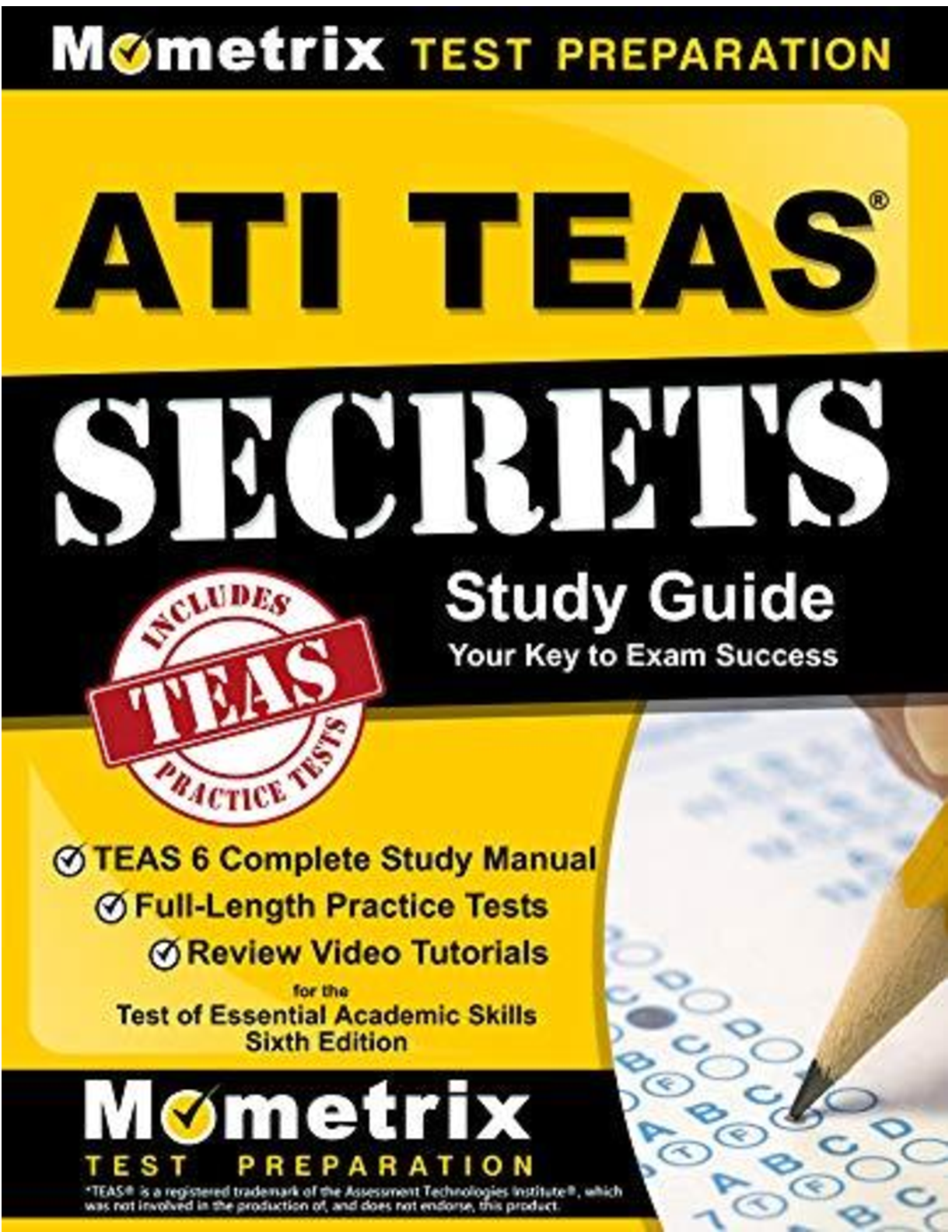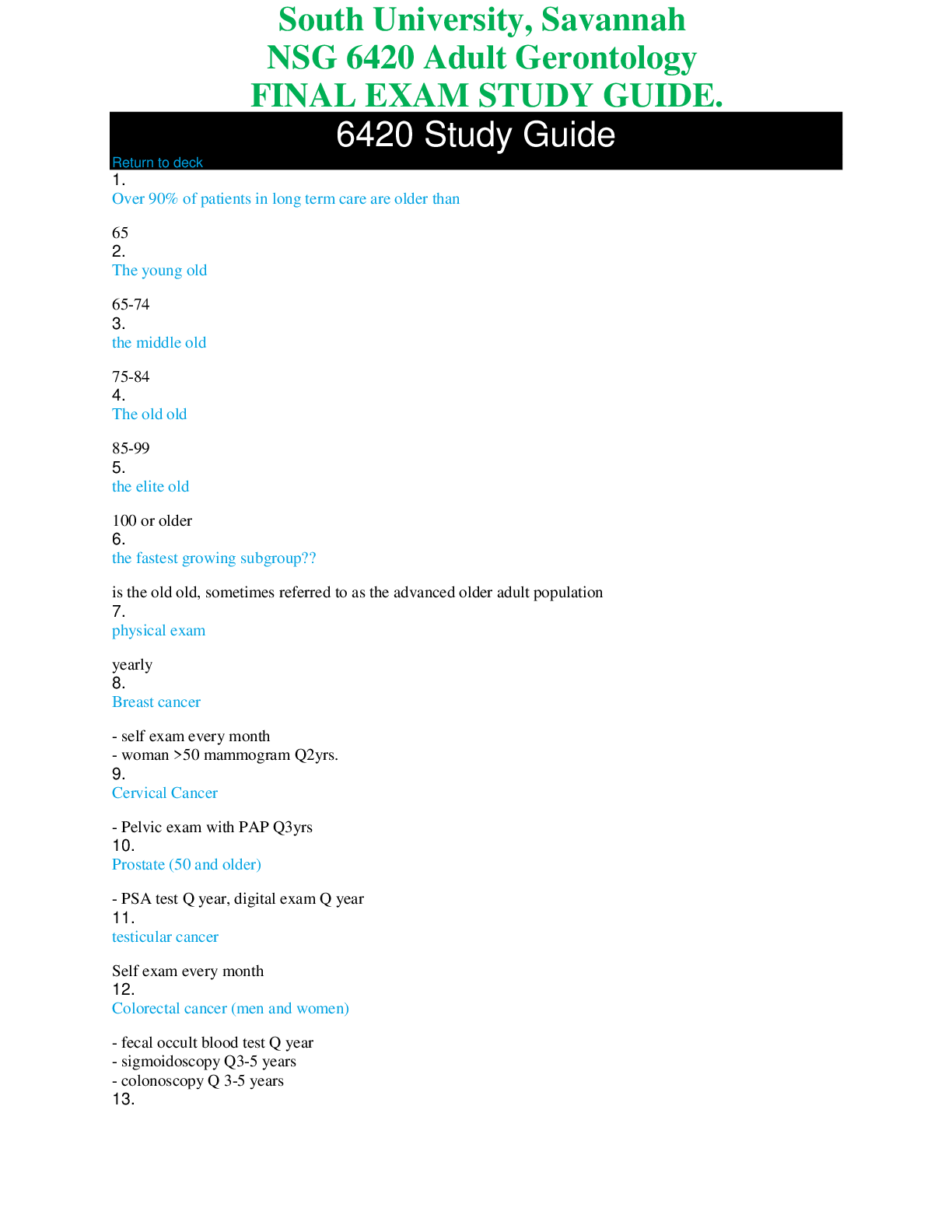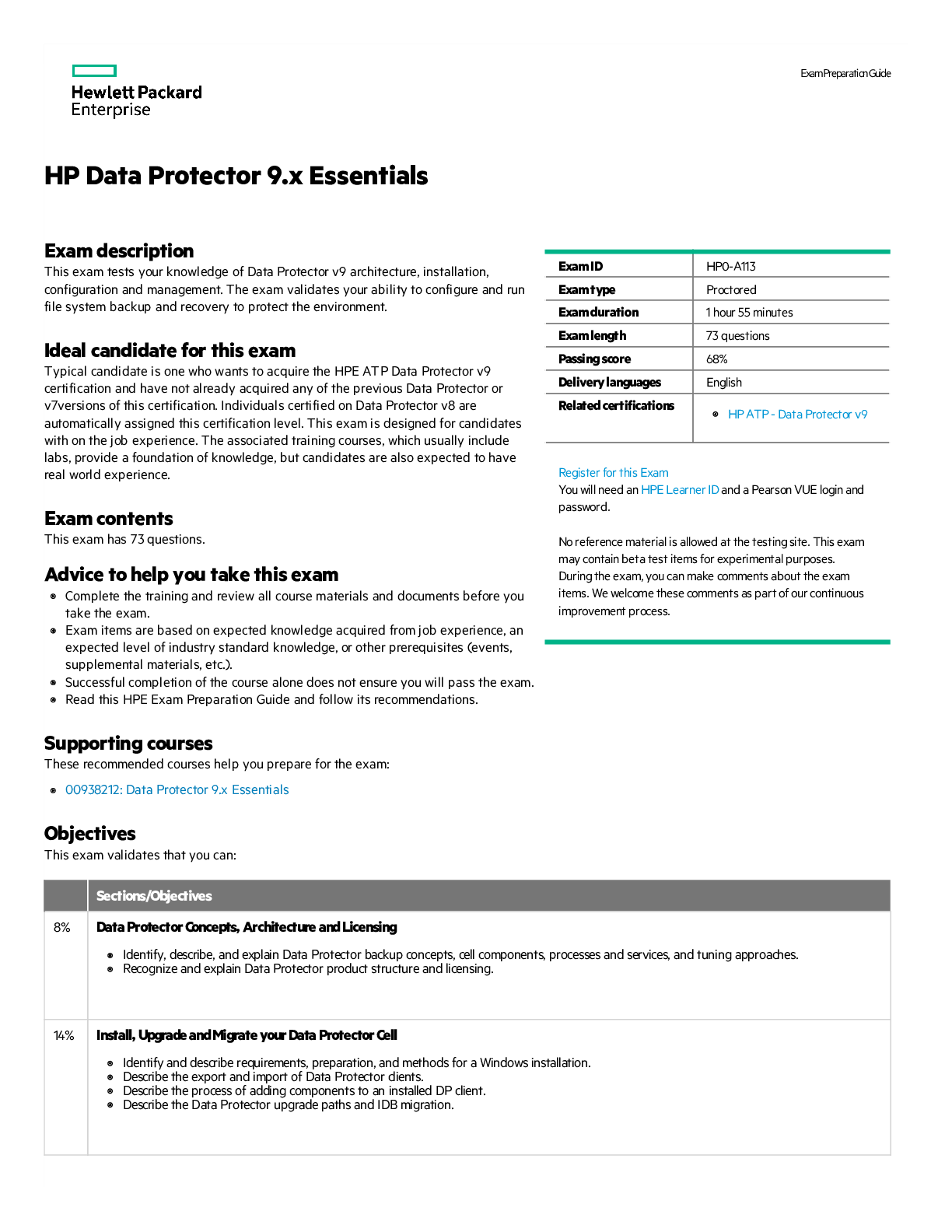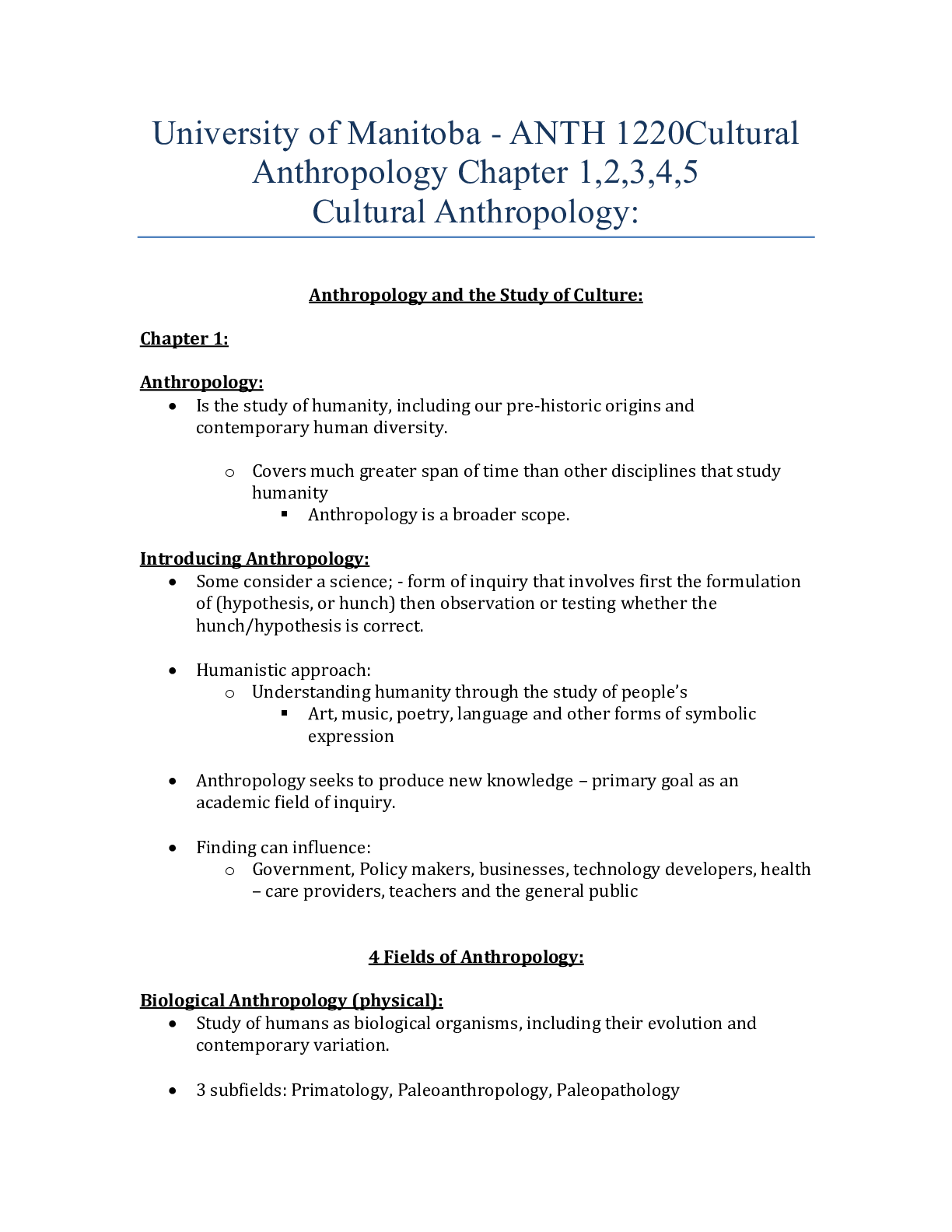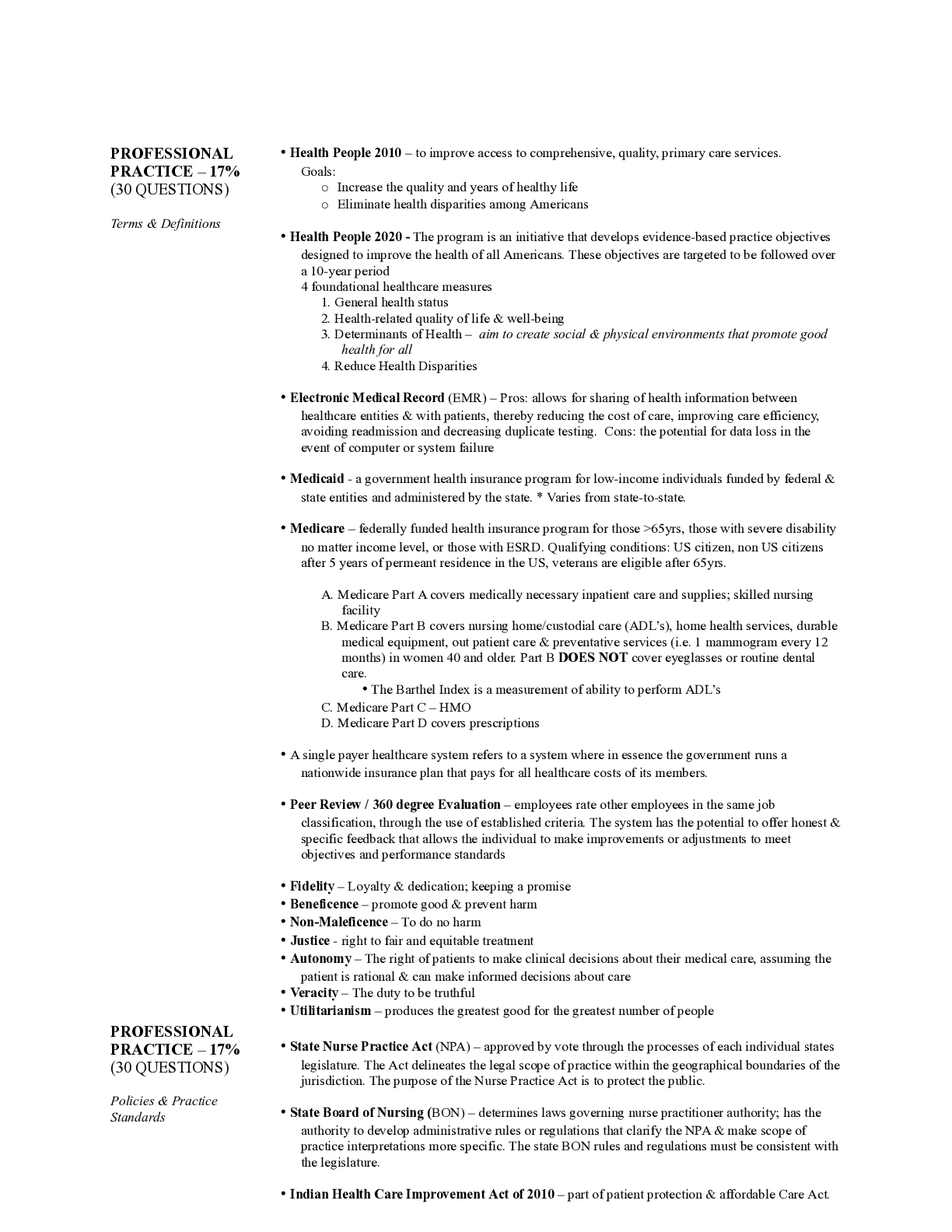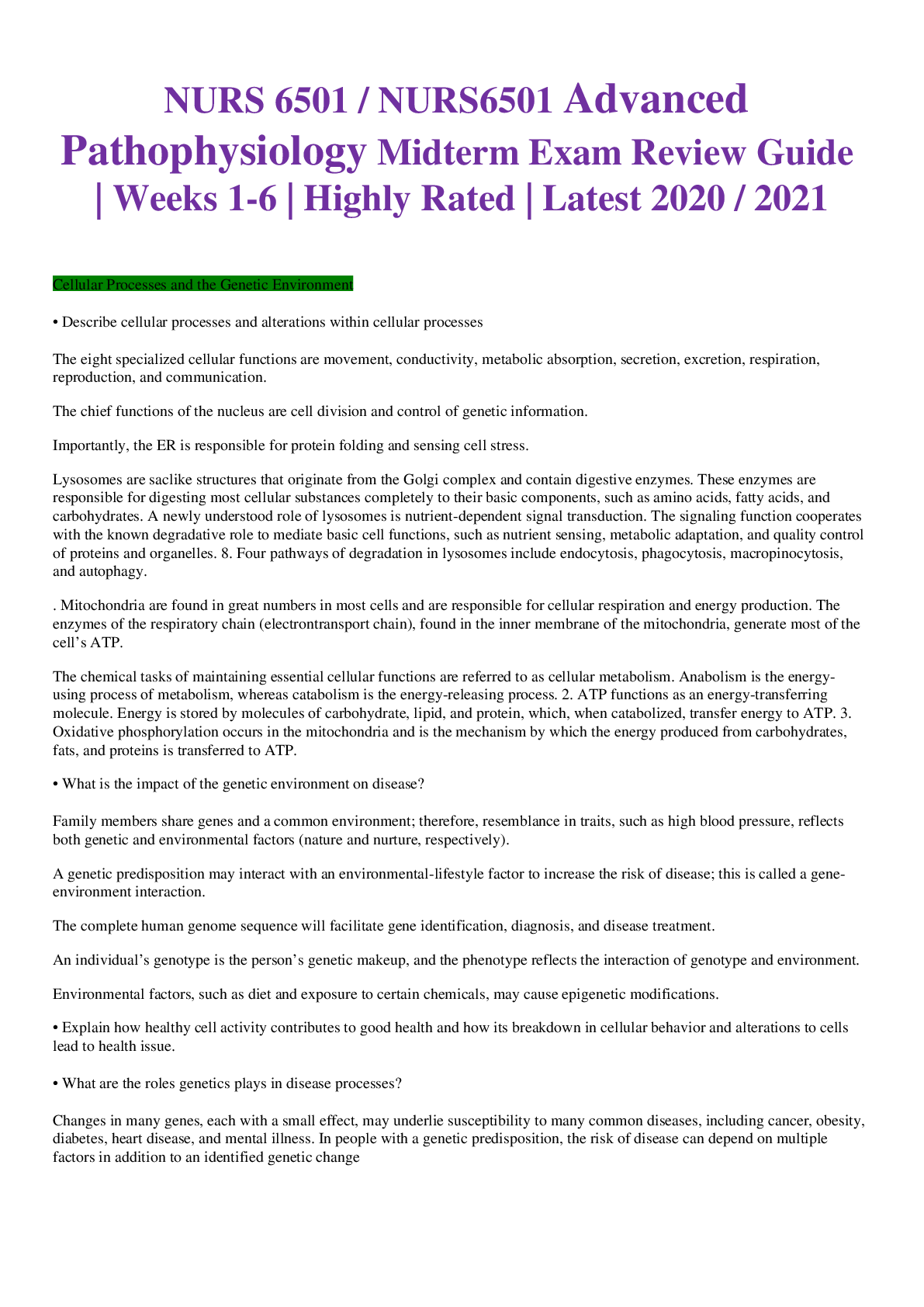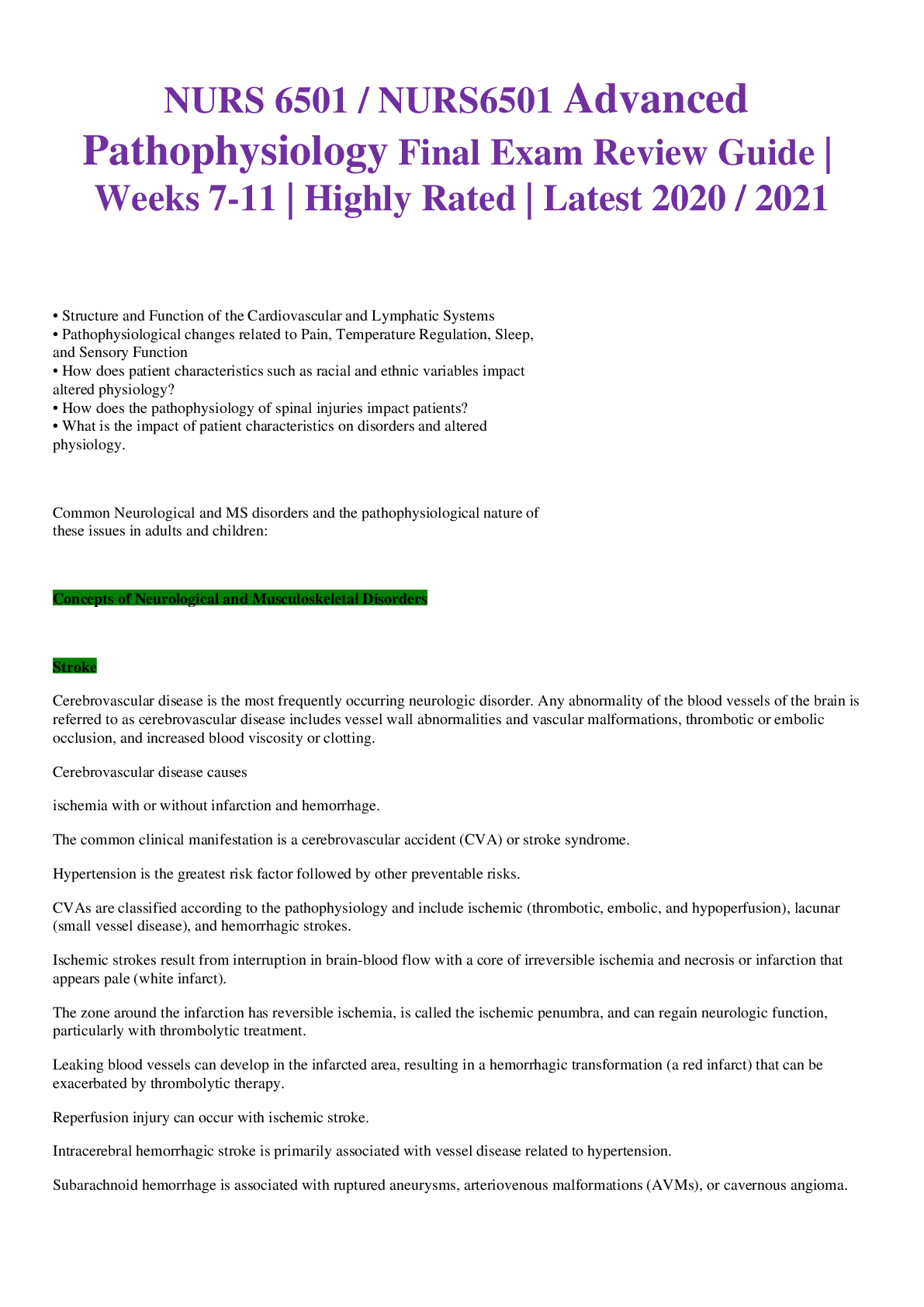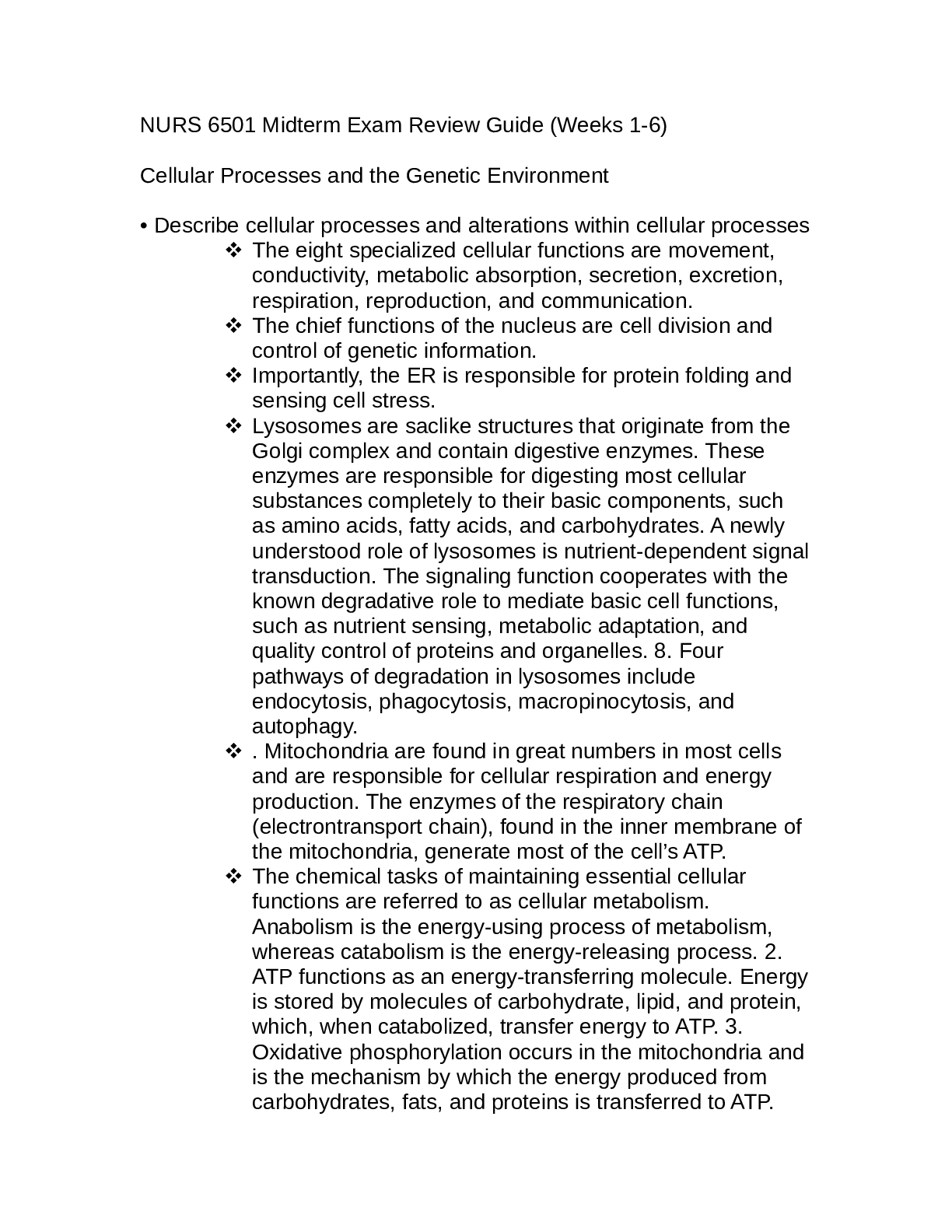*NURSING > STUDY GUIDE > Walden University - NURS 6550NMIDTERM Exam Review Guide (All)
Walden University - NURS 6550NMIDTERM Exam Review Guide
Document Content and Description Below
NURS 6550 Midterm Exam Review (Week 1-6) Medicolegal Considerations and the Role of the Advanced Practice Nurse • Coding and billing in nursing practice o ICD-10, CPT, and E&M codes • Role o... f the acute care nurse practitioner o populations, limitations, common practice settings • Certification exam content areas • Informed consent • HIPPA and patient confidentiality • Radiology – appropriate orders and interpreting reports • Evaluation, differential diagnosis, diagnostic studies, and treatment options for common symptoms o Cough o Dyspnea o Hemoptysis o Chest pain o Palpitations o Lower extremity edema o Fever and hyperthermia o Involuntary weight loss o Fatigue o Acute headache o Dysuria • Assessment of the older adult • Evaluation, differential diagnosis, and treatment of geriatric disorders o Dementia Types, differentiating different types, treatment o Delirium (how to differentiate between dementia and delirium) Common causes, assessment, treatment o Urinary incontinence o Skin pressure injuries • Care of patients at the end of life o Symptom treatment / pain control o Decision making o DNR orders • Pain Management o Differentiate types of pain (acute, chronic, cancer) o Classes of medications to treat pain (opioids, NSAIDS, adjuvant) o Side effects and adverse effects of the medications • Medications that treat neuropathic pain o complications Psychosocial Health Conditions • Evaluation, differential diagnosis, and treatment of psychiatric disorders (review medication indications of treatment and medication complications) o Trauma and stress related trauma disorders o Anxiety disorders / panic attack treatment o Somatic symptom disorders o Chronic pain o Personality disorders o Bipolar disorder Long term treatment, monitoring, complications o Schizophrenia o Depression and mania (Initial treatment and common side effects to monitor for) o Substance use disorders Conditions of the Eye, Ear, Nose, and Throat • Evaluation, differential diagnosis, and treatment of eye, ENT disorders o Conjunctivitis Differentiate between viral, bacterial, gonococcal o Infectious keratitis o Glaucoma Acute vs chronic Diagnosis – use tonometry treatment o Cataract o Retinal detachment o Macular degeneration o Optic disc swelling o Ocular trauma o Corneal abrasion o Orbital cellulitis o Orbital trauma o Hearing loss Conductive vs sensorineural o Otitis media o Cholesteatoma o Vertigo Evaluation and treatment o Sinusitis o Nasal trauma / bleeding Use of nasal packing o Pharyngitis / peritonsillar abscess o Epiglottitis o Salivary gland disorders o Bell’s palsy • Procedures – review the indications, procedure, and patient instructions o Eyebrow laceration repair o Woods light evaluation of the eye o Eyelid eversion o Tooth avulsion and fracture Cardiovascular Conditions • Evaluation, differential diagnosis, treatment options, and complications o Congenital heart disease Pulmonary valve stenosis Coarctation of the aorta Atrial septal defect Ventricular septal defect Tetralogy of fallot Patent ductus arteriosus o Valvular heart disease (differentiate each of these from the others, diagnosis, treatment, murmurs location) Mitral stenosis Mitral regurgitation Mitral valve prolapse Aortic stenosis Aortic regurgitation Tricuspid stenosis Tricuspid regurgitation Pulmonary valve regurgitation o Coronary artery disease o Angina o Coronary vasospasm (what drug class NOT to use for this dx) o Acute Coronary syndromes (NSTEMI) o Acute Myocardial infarction (STEMI) Initial treatment When is fibrinolytic therapy indicated Contraindications to fibrinolytic therapy o Arrythmias Different classes of medications Medication indications for specific rhythms Be able to recognize arrythmias on 12 lead EKG – review book and simulator (http://www.skillstat.com/tools/ecg-simulator#/-home) Bradycardia / tachycardia Superventricular tachycardia Atrial fibrillation • Treatments including indication for anticoagulation • Be familiar with the clinical practice guideline on anticoagulation management Ventricular tachycardia / fibrillation Syncope o Heart failure Differentiate systolic / diastolic failure Review heart murmurs and their association with pathology NY Heart rating scale First line treatment How treatment differs based on ejection fraction o Myocarditis o Cardiomyopathies Differentiate between types How assessment and treatment differs between types o Pericarditis 12 lead EKG changes seen in pericarditis Diagnostic criteria treatment o Endocarditis Duke criteria Common causes Common symptoms o Pericardial effusion / tamponade o Pulmonary Hypertension o Hypertension Be very familiar with practice guideline JNC 9 Target BP by age Treatment based on co-morbidities Hypertensive urgency / emergency – diagnostic criteria o Atherosclerotic peripheral vascular disease (symptoms) Aortic and iliac occlusions Femoral and popliteal occlusions Tibial and pedal occusions o Occlusive cerebrovascular disease Diagnosis and treatment o Abdominal aortic aneurysms o Thoracic aortic aneurysms Monitoring and treatment guidelines o Peripheral artery aneurysms o Aortic dissection o Shock How to differentiate between the types of shock Be familiar with the shock guidelines via Surviving Sepsis Hemodynamic readings related to each shock type treatment o Thrombophlebitis o Venous insufficiency Diagnosis and treatment o Lipid disorders Be familiar with the 2018 practice guideline on management of blood cholesterol Be able to use the risk calculator • Procedures o Be able and familiar with EKG interpretation o Use the simulator to practice o Know the criteria for each arrhythmia, AV block, STEMI with associated location o Defibrillation - indications and procedure Respiratory System • Evaluation, differential diagnosis, treatment options, and complications o Asthma Be familiar with the Global Initiative for Asthma, diagnostic criteria, step wise approach to treatment Be familiar with the FEV monitoring and intervention o COPD GOLD classification and treatment recommendations Indication for supplemental oxygen Smoking cessation / stages of change o Bronchiectasis o Cystic fibrosis o Bronchitis o Pneumonia Differentiate CAP, HAP, and VAP along with treatment changes VAP prevention / risk factors CURB-65 criteria o Pulmonary tuberculosis Monitoring, when to treat, how to treat, when to report o Pulmonary neoplasms o Interstitial lung disease o Sarcoidosis o Pulmonary Embolism Treatment – be familiar with the CHEST guidelines for anticoagulation management (2016) Diagnosis – effectiveness of D-dimer / what effects result Congenital risk factors o Pulmonary hypertension o Smoke inhalation o Aspiration syndromes o Pleuritis o Pleural effusion Lab findings related to the pleural fluid o Pneumothorax o Obstructive sleep apnea o Acute Respiratory Failure Different types of respiratory support Ventilator management / blood gases o ARDS Phases Clinical symptoms o Hypothermia o Drowning o Burns o Altitude sickness o Sepsis Be familiar with the Surviving Sepsis guidelines Diagnosis Monitoring Treatment Differentiate SIRS/Sepsis/MODS • Procedures o Peak flow meter o Pulmonary function tests Be familiar with how to differentiate different disease Determine baseline and disease progreassion o Stress tests o Chest xray interpretation Review and be able to do some basic interpretation Gastrointestinal System • Evaluation, differential diagnosis, treatment options, and complications o Dyspepsia o Nausea / vomiting o Constipation /diarrhea o GI Bleeding o Ascites o Bacterial Peritonitis o GERD o Esophagitis o Esophageal lesions treatment o Esophageal varices o Achalasia o Gastritis o PUD o Zollinger-Ellison Syndrome o Celiac disease o Acute paralytic ileus o Appendicitis o Irritable bowel syndrome o Colitis o Inflammatory bowel disease o Crohns disease o Ulcerative colitis o Diverticulitis o Jaundice o Hepatitis Differentiate between all types Know the serologic testing o Acute liver failure o Alcoholic liver disease o Non alcoholic fatty liver disease o Cirrhosis o Non cirrhotic portal hypertension o Cholelithiasis o Cholecystitis o Choledocholithiasis o Pancreatitis o Protein energy malnutrition o Obesity o Anorexia o Bulimia o Vitamin deficiencies o Enteral nutrition When to use o Parenteral nutrition When to use complications • Procedures o Abdominal xray interpretation o Nasogastric tube insertion [Show More]
Last updated: 1 year ago
Preview 1 out of 8 pages
Instant download
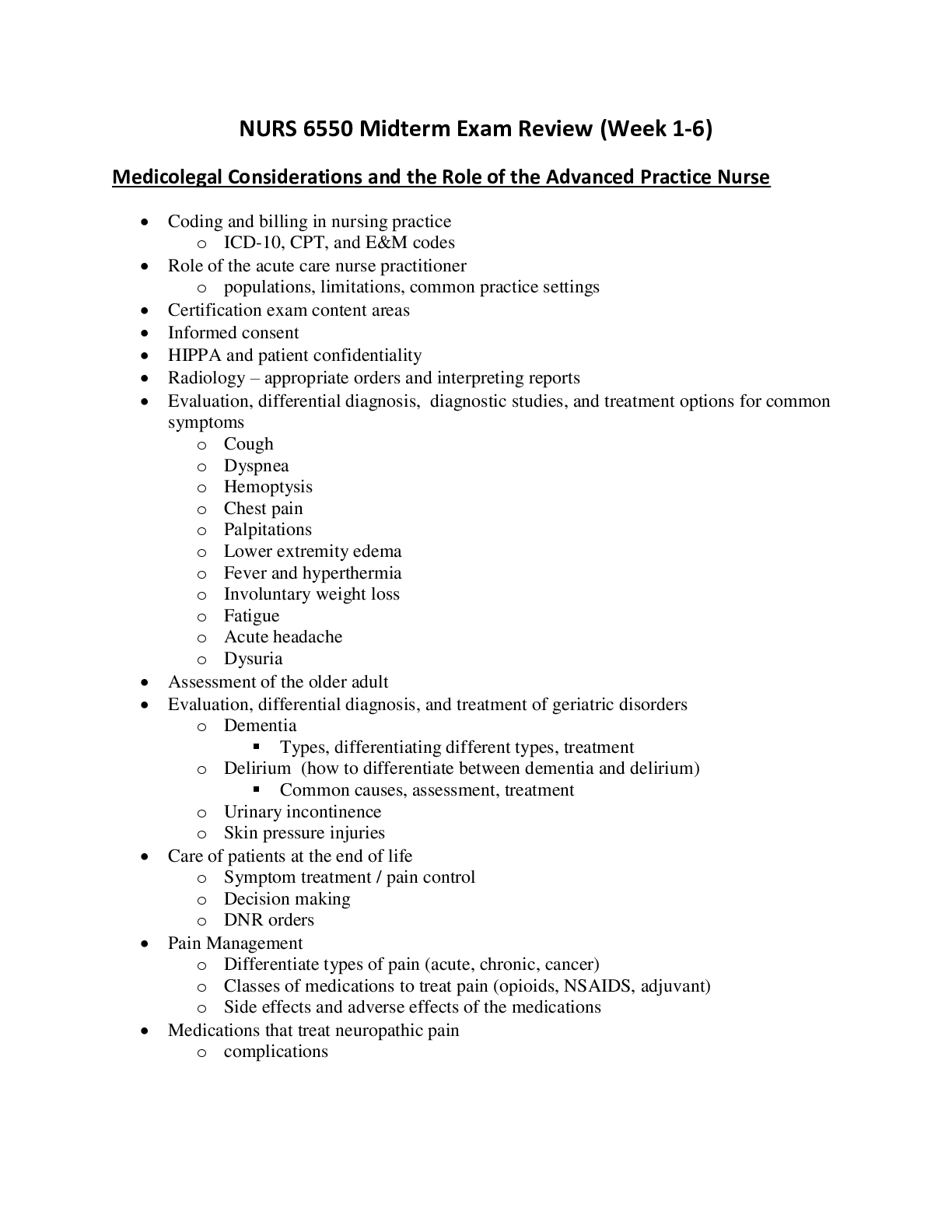
Buy this document to get the full access instantly
Instant Download Access after purchase
Add to cartInstant download
Reviews( 0 )
Document information
Connected school, study & course
About the document
Uploaded On
Feb 05, 2020
Number of pages
8
Written in
Additional information
This document has been written for:
Uploaded
Feb 05, 2020
Downloads
0
Views
46


